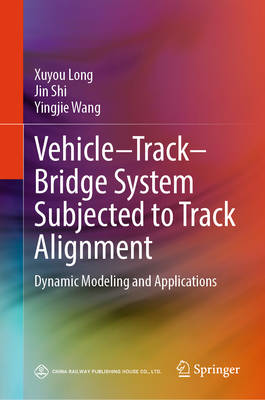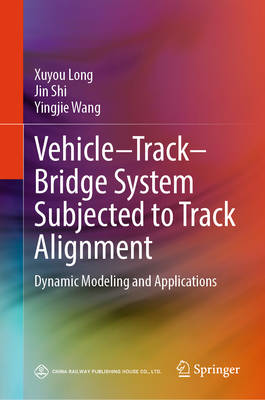
- Afhalen na 1 uur in een winkel met voorraad
- Gratis thuislevering in België vanaf € 30
- Ruim aanbod met 7 miljoen producten
- Afhalen na 1 uur in een winkel met voorraad
- Gratis thuislevering in België vanaf € 30
- Ruim aanbod met 7 miljoen producten
Zoeken
Vehicle-Track-Bridge System Subjected to Track Alignment
Dynamic Modeling and Applications
Xuyou Long, Jin Shi, Yingjie Wang
Hardcover | Engels
€ 305,45
+ 610 punten
Omschrijving
This book delves into the dynamic issues of railway vehicles and track/bridge structures. This area has been a focus of railway engineering since the 1990s, driven by the speed-increasing of existing railway and the development of high-speed railway research in China. The book critically examines the dynamical interactions within the railway vehicle-track-bridge system subjected to track alignment, transcending the limitations of traditional quasi-static methods and offering a novel perspective for analyzing track alignment design parameters with respect to safety and comfort. Introducing a novel approach, this book applies railway vehicle-track/bridge system dynamics to track alignment studies, tackling unique challenges such as non-linear wheel-rail relationships and spatial geometric conditions of track curves. It also addresses the challenge of long track lengths (typically spanning tens of kilometers) and presents innovative modeling and solution methods, making it a valuable reference in railway system dynamics. The content covers foundational dynamic principles, comprehensive modeling of railway vehicles, track, and bridge structures, and practical engineering applications. Through detailed case studies, readers will gain insights into the real-world application and optimization of track alignment using dynamic evaluation methods. Intended for researchers and practitioners with a background in railway engineering, this book bridges the gap between theoretical research and practical implementation. It is especially valuable for those involved in high-speed and heavy-haul railway projects.
Specificaties
Betrokkenen
- Auteur(s):
- Uitgeverij:
Inhoud
- Aantal bladzijden:
- 417
- Taal:
- Engels
Eigenschappen
- Productcode (EAN):
- 9789819516483
- Verschijningsdatum:
- 31/12/2025
- Uitvoering:
- Hardcover
- Formaat:
- Genaaid
- Afmetingen:
- 155 mm x 235 mm

Alleen bij Standaard Boekhandel
+ 610 punten op je klantenkaart van Standaard Boekhandel
Beoordelingen
We publiceren alleen reviews die voldoen aan de voorwaarden voor reviews. Bekijk onze voorwaarden voor reviews.








